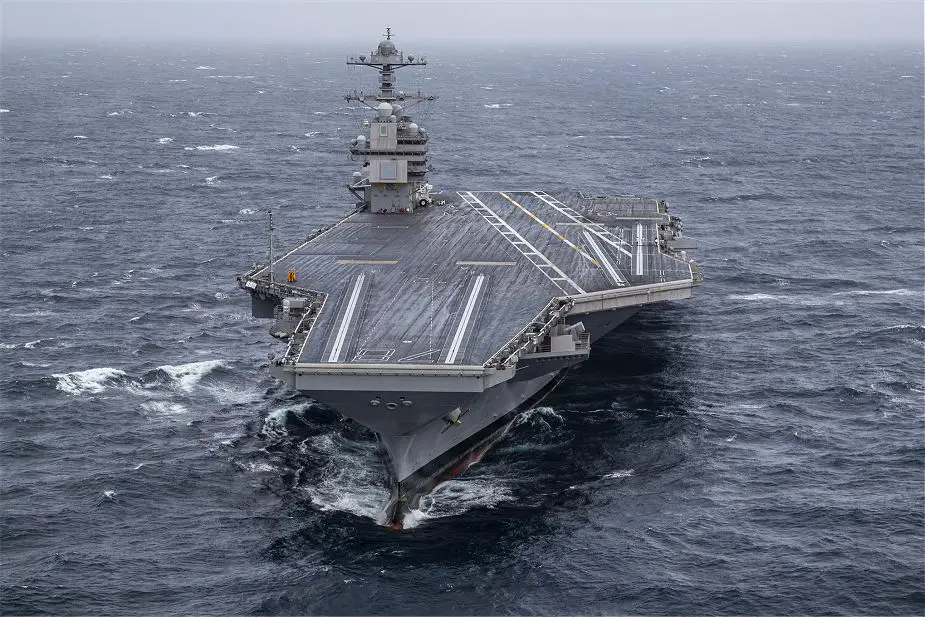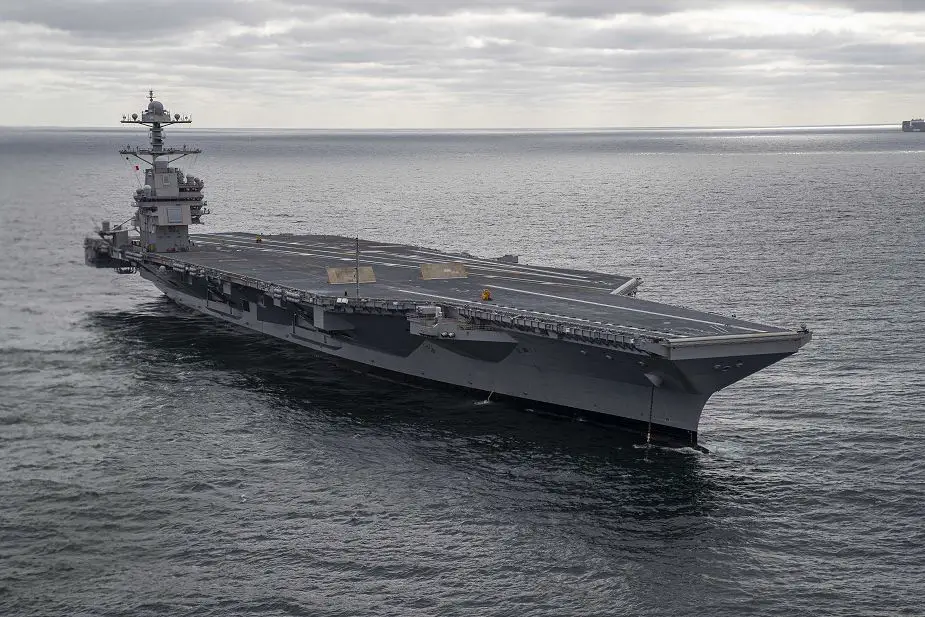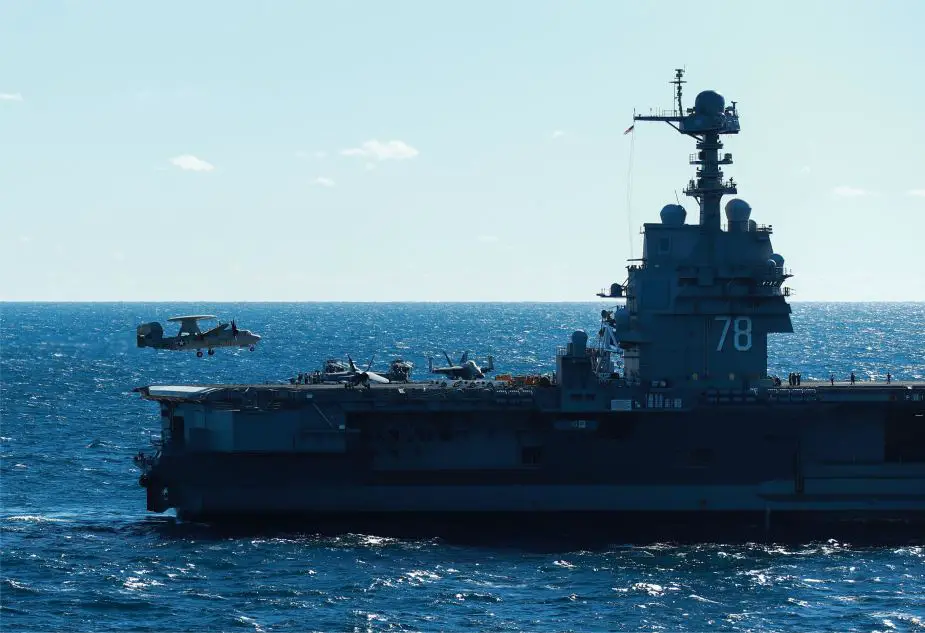Analysis: US Navy Program CVN 78 Gerald R. Ford-Class Nuclear Aircraft Carrier
The CVN 78 Gerald R. Ford-class aircraft carrier program introduces a new class of nuclear-powered aircraft carriers. It uses the same hull form as the CVN 68 Nimitz-class but introduces a multitude of new ship systems.
 The aircraft carrier USS Gerald R. Ford (CVN 78) steams in the Atlantic Ocean, Oct. 27, 2019, for the first time since July 2018. Gerald R. Ford is conducting sea trials following its 15 month post-shakedown availability. October 27, 2019. (Picture source US Navy)
The aircraft carrier USS Gerald R. Ford (CVN 78) steams in the Atlantic Ocean, Oct. 27, 2019, for the first time since July 2018. Gerald R. Ford is conducting sea trials following its 15 month post-shakedown availability. October 27, 2019. (Picture source US Navy)
The U.S. Navy redesigned weapons elevators, handling spaces, and stowage to reduce manning, improve safety, and increase weapon throughput. Weapon elevators utilize electromagnetic linear induction motors instead of cable driven systems.
The CVN 78 Gerald R. Ford-class aircraft carrier incorporates a more efficient flight deck layout, dedicated weapons handling areas, and an increased number of aircraft refueling stations designed to enhance its ability to launch, recover, and service aircraft.
The CVN 78 combat system incorporates changes intended to improve upon the legacy Nimitz-class combat system. It consists of a phased-array DBR (Dual Band Radar) comprised of the SPY-4 Volume Search Radar and the SPY-3 MFR. The DBR replaced several legacy radars used on current carriers for self‑defense and air traffic control.
Onboard combat systems also include ship Self-Defense System (SSDS) Mark 2 command decision system, CEC (Cooperative Engagement Capability) tracking and data fusion and distribution system, Surface Electronic Warfare Improvement Program (SEWIP) Block 2-equipped SLQ-32(V)6 electronic surveillance system, Rolling Airframe Missile (RAM) Block 2 and Evolved SeaSparrow Missile (ESSM) Block 1 and Phalanx Close-In Weapon System.

The aircraft carrier USS Gerald R. Ford (CVN 78) raises its anchor during a precision anchoring evolution while at sea for the first time in 2019. (Picture source US. Navy)
In June 2019, the Navy conducted one of the four planned CVN 78 operational tests planned for FY19 on the SDTS. However, the remaining three tests are unlikely to be conducted in accordance with the DOT&E-approved CVN 78 data collection plan, the DOT&E-approved Capstone Enterprise Air Warfare Ship Self-Defense TEMP, and the DOT&E-approved SSDS TEMP.
The CVN 78 SDTS (Self-Defense Test Ship ) events revealed good performance of the SSDS Mark 2 command decision system due to its ability to manage the combat system tracks, manage and apply the ship’s engagement doctrine, and schedule intercepts and launch missiles against incoming subsonic anti-ship cruise missile (ASCM) surrogates.
In the most recent CVN 78 SDTS developmental test event, the MFR and CEC failed to maintain detections and tracks for one of the threat surrogates in the multi-target raid; however, that raid presented a scenario that was more challenging to the combat system than originally planned. In developmental testing on SDTS, the SLQ-32(V)6 electronic surveillance system demonstrated poor performance that prompted the Navy to delay additional operational tests until those problems could be corrected. Similar problems were previously reported in DOT&E’s September 2016 SLQ-32(V)6 SEWIP Block 2 IOT&E report.
The U.S Navy continues to address known deficiencies with the DBR Air Traffic Control (ATC), but the resolution of those problems will not be known until CVN 78 returns to sea. In at-sea testing before the PSA, DBR was plagued by extraneous false and close-in dual tracks adversely affecting ATC performance, and Navy analysis noted that DBR performance needs to be improved to support carrier ATC center certification.

An E-2D Hawkeye, assigned to Air Test and Evaluation Squadron (VX) 20, prepares to land on the flight deck of the aircraft carrier USS Gerald R. Ford (CVN 78). (Picture source U.S. Navy)
In January 2020, the aircraft carrier USS Gerald R. Ford (CVN 78) completed Aircraft Compatibility Testing (ACT) following 16 days at sea, during which the crew launched and recovered 211 aircraft, testing five different airframes, using first-generation, state-of-the-art flight deck systems.
The testing phase included the first-ever underway catapult launches and arrested landings for the T-45 Goshawk and E/A-18G Growler from Air Test and Evaluation Squadron 23 (VX-23); as well as the E-2D Advanced Hawkeye and C-2A Greyhound, from Air Test and Evaluation Squadron 20 (VX-20). Crews also tested F/A-18F Super Hornets from VX-23, which earlier had conducted initial compatibility tests onboard Ford in 2017.


























